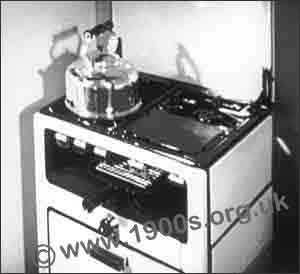The gas cooker in the modern 1940s UK suburban kitchen
In the 1920s and 30s, ovens and hobs powered by gas came onto the market, representing a sea change in cooking, labour-saving and elegance after the kitchen ranges of earlier times. This page uses a late-1930s cooker in a 1940s kitchen to explain.
____
By the webmaster, based childhood observations, discussions with people who lived in these houses and additional research
The cooker that I remember in my parents' 1940s suburban kitchen was bought in the late 1930s and was more elegant than anything that could have been bought in 1940s wartime and the aftermath of continuing austerity. It was of course free-standing as there were no kitchen units as we know them today.

Gas cooker, bought in the late 1930s and used in the 1940s kitchen. Detail of a photograph which shows the very same cooker that my family had. The kettle, though, is a later version.
The cooker - why always called the 'gas oven'
The cooker was powered by gas with a hob on top - although 'hob' was not a word that I heard used until much later.
Interestingly, because of my mother's childhood with coal fired kitchen ranges for cooking, this cooker was always called the 'gas oven' until her dying day. This was for the entire cooker, hob and all. It was never the 'cooker' or the 'oven' or the 'hob' just the 'gas oven'.
The gas fuel - a labour-saving innovation
Because the cooker was powered by gas, no-one had to go outside to shovel coal as they would have done for the earlier kitchen ranges.
Furthermore, the gas gave instant heat on the hob, although there was a warm-up time for the oven. Warm-up time for heating saucepans on the old kitchen ranges could take as much as an hour.
The appearance of the cooker
The oven and hob combination was really modern by the standards of the time because it was finished in gleaming white enamel with black fittings (in contrast to the more normal dark grey of the cast iron grey of kitchen ranges).
Out of sight in the picture is an integral drawer below the oven. It was gleamng white, too. Cake tins and meat tins were stored in it.
The pilot light
There was a special feature of a pilot light for the gas rings on the hob - but not for the oven. Most of the gas rings in other houses had to be lit with matches or a flint gadget.
How to light an early gas rings with no pilot light
contributed by Laurie Prior
My mother and granny both had squeeze type flint sparkers to light the gas cooker rings.
Later models of gas cooker around the early 1950s such as the GLC (Gas Light and Coke Company) or New World, had a lighter in a holster with a flexible gas pipe feed tube. A push button on the top would make the spark and feed the gas to the nozzle. The handle had an old type U11 battery in it. A long flame shot out of the end and you pointed it into the gas ring to light up the hobs accordingly.
Thermostatic control
Another very welcome innovation was what was known as the 'regulo' to set and thermostatically maintain the temperature of the oven. This was really novel for my mother who was used to old coal-fired kitchen ranges. To her dying day, she insisted that the kitchen and outside door had to be kept shut while she was cooking a cake, so that the oven wouldn't cool down. She refused to understand thermostats.
The grill
There was a grill tray between the hob and the oven - another labour-saving device. In the past, making toast involved using a long-handled toasting fork in front of a coal-fire. My mother refused to use this innovation, saying that it made a smell, not that anyone else seemed to complain of this. More likely, having been brought up to manage without a grill, she preferred the older methods.
The hob lid
The hob had a white enamelled lid that could close down, presumably for tidiness. However, it never was closed down in our home. The kettle had to stand somewhere and the open hob was the best place as it would have eventually scratched the enamel lid of the hob.
| sources | webmaster | contact |
Text and images are copyright
If you can add anything to this page or provide a photo, please contact me.



